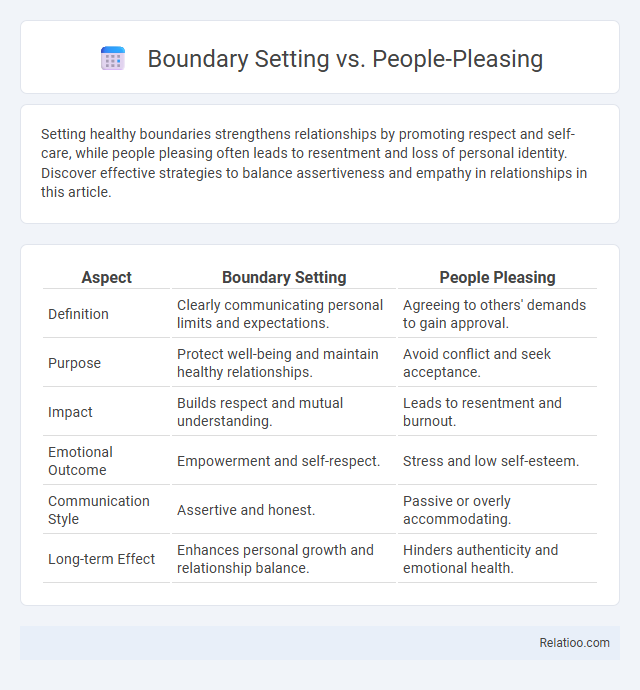Setting healthy boundaries strengthens relationships by promoting respect and self-care, while people pleasing often leads to resentment and loss of personal identity. Discover effective strategies to balance assertiveness and empathy in relationships in this article.
Table of Comparison
| Aspect | Boundary Setting | People Pleasing |
|---|---|---|
| Definition | Clearly communicating personal limits and expectations. | Agreeing to others' demands to gain approval. |
| Purpose | Protect well-being and maintain healthy relationships. | Avoid conflict and seek acceptance. |
| Impact | Builds respect and mutual understanding. | Leads to resentment and burnout. |
| Emotional Outcome | Empowerment and self-respect. | Stress and low self-esteem. |
| Communication Style | Assertive and honest. | Passive or overly accommodating. |
| Long-term Effect | Enhances personal growth and relationship balance. | Hinders authenticity and emotional health. |
Understanding Boundary Setting
Understanding boundary setting involves recognizing and communicating personal limits to protect emotional well-being and maintain healthy relationships. Unlike people pleasing, which often sacrifices individual needs to gain approval, effective boundary setting fosters mutual respect and reduces internal dissonance caused by conflicting desires. Clear boundaries help prevent emotional burnout and promote authenticity by aligning actions with personal values.
What is People Pleasing?
People pleasing is a behavioral pattern characterized by prioritizing others' needs and desires over one's own, often at the expense of personal boundaries and well-being. This tendency stems from a deep-seated fear of rejection or conflict, leading individuals to seek approval through excessive compliance. Unlike healthy boundary setting, people pleasing results in emotional dissonance, where inner feelings are suppressed to maintain external harmony.
Key Differences Between Boundaries and People Pleasing
Boundary setting involves clearly communicating your limits to protect your well-being, while people pleasing prioritizes others' approval often at the expense of your own needs. People pleasing leads to internal dissonance, where your actions conflict with personal values, causing stress and resentment. Your ability to establish boundaries fosters healthier relationships by reducing emotional dissonance and promoting mutual respect.
Signs You Are Struggling With Boundaries
Struggling with boundaries often manifests as difficulty saying no, feeling overwhelmed by others' demands, and experiencing persistent guilt when prioritizing personal needs. People pleasers frequently sacrifice their own well-being to avoid conflict, leading to emotional exhaustion and resentment. Cognitive dissonance arises when actions contradict values, causing stress and inner turmoil linked to unclear or weak boundary enforcement.
Why People Please: Root Causes
People please often stems from deep-rooted fears of rejection, low self-esteem, and a strong desire for external validation, which override their personal boundaries. Childhood experiences, such as neglect or conditional love, can instill patterns of seeking approval to avoid conflict or emotional pain. This persistent need to satisfy others leads to internal dissonance, where personal values clash with actions taken to appease those around them.
Benefits of Healthy Boundary Setting
Healthy boundary setting fosters emotional resilience, reduces stress, and enhances interpersonal relationships by clearly defining personal limits and expectations. Unlike people-pleasing, which often leads to resentment and burnout, establishing boundaries promotes self-respect and mutual understanding. Maintaining healthy boundaries minimizes cognitive dissonance, aligning actions with values and supporting overall well-being.
The Consequences of Chronic People Pleasing
Chronic people pleasing often leads to emotional exhaustion, diminished self-worth, and an increased risk of anxiety and depression due to the constant suppression of personal needs and boundaries. This behavior fosters cognitive dissonance as individuals conflict between their true desires and actions aimed at appeasing others, resulting in internal stress and identity confusion. Establishing clear boundaries is essential to mitigate these negative outcomes, promoting healthier relationships and improved mental well-being.
Strategies for Setting Stronger Boundaries
Setting stronger boundaries involves clearly communicating your limits and prioritizing your well-being to reduce emotional dissonance caused by people-pleasing tendencies. Effective strategies include assertive communication, recognizing and honoring your needs without guilt, and practicing self-awareness to identify when your boundaries are being compromised. By implementing these approaches, you empower yourself to maintain healthier relationships and prevent stress from unmet expectations.
Overcoming the Fear of Disappointing Others
Overcoming the fear of disappointing others requires distinguishing between boundary setting, people pleasing, and cognitive dissonance. Boundary setting involves asserting personal limits to protect well-being, while people pleasing prioritizes others' approval at one's own expense, intensifying internal conflict. Resolving cognitive dissonance by aligning actions with authentic values diminishes anxiety linked to disappointing others and fosters healthier relationships.
Building Confidence in Assertive Communication
Establishing clear boundaries empowers you to communicate assertively without compromising your values, reducing feelings of dissonance caused by people-pleasing behaviors. Recognizing the difference between healthy self-assertion and excessive accommodation strengthens your confidence in expressing needs and limits. Consistent boundary setting fosters self-respect and trust, essential for resilient and authentic interpersonal connections.

Infographic: Boundary Setting vs People Pleasing
 relatioo.com
relatioo.com